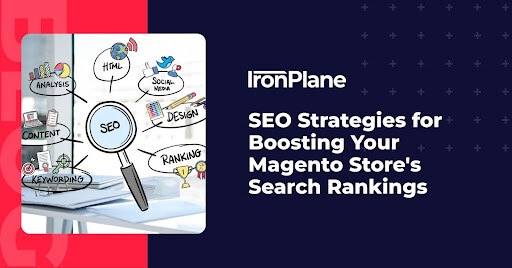9 Optimization Secrets from BigCommerce Developers
Unlock top optimization best practices from seasoned BigCommerce developers. Elevate your online store's performance and user experience today.

On-page SEO is the practice of building pages on your own website with engaging, valuable content containing relevant keywords. On-page SEO should be a key component of your overall SEO strategy. Luckily, by building your website using BigCommerce design, you will significantly increase SEO content optimization. BigCommerce makes it easier for web crawlers to crawl your online content and send your page information to Google and Bing.
Information sent from a server to a computer does not travel instantly. Google does not want their users to get frustrated having to wait for a website to load, meaning your site will rank lower in the SERPs.
BigCommerce’s content delivery network consists of servers in different locations around the world. Each server contains cached versions of websites, and people searching on the net will get information from the closest one. Accessing a nearby server means a better user experience for your visitors because they have less time to wait. Shorter waiting times also mean better rankings on Google.
As with any platform, utilizing keywords in BigCommerce is imperative to the success of your SEO efforts. Keywords are essential because they tell Google what your website is all about. When people search for items using corresponding keywords, Google will recognize a match between what you have and what people want.
Throughout the BigCommerce control panel, there are areas to enter content specifically for SEO purposes, including keywords. Keywords can be filled in for content pages, category pages, product pages, blog posts, and brands, allowing for maximum SEO impact.
Building an eCommerce website is made significantly more user-friendly with templates. Templates save a great deal of time and eliminate the need for a vast amount of technical know-how while also offering the ability for customizations.
BigCommerce themes are optimized to help with several factors, including SEO. BigCommerce Development offers a selection of free themes that are ideal for many people getting started. There are also premium (paid) themes if you are looking for something a bit more advanced.
Hiring a professional team of BigCommerce developers will offer the most customization. Thus, having your website built from scratch has various advantages. These advantages include having your site custom-designed and will allow greater flexibility when upgrading and modifying your site. Using a certified BigCommerce partner can help you create the website you need to achieve your goals.
Blogging is an effective way of creating content that is beneficial to SEO. Statistically, companies with a focus on blogging get around 13 times the ROI than they otherwise would. With a BigCommerce blog, you can create relevant content right from your dashboard. By including your targeted keywords, you will have a better chance of ranking well in the SERPS. People also like to share good quality content with other people, and sharing will help you build a natural portfolio of good quality backlinks.
Creating high-quality content on a consistent basis can be extremely time-consuming and finding professional content writers is challenging. Fortunately, there are content marketing services available to produce custom content for your website that will help increase your Google ranking and keep your visitors engaged.
Good SEO takes time. One way to generate more revenue and increase your ranking in the SERPs is to utilize the benefits of Google Shopping.
With Google Shopping, you can hire an eCommerce marketing agency to build Google Shopping ads featuring products from your online BigCommerce store. Thus, these products will show up in Google search results. More importantly, these paid digital shopping ads will increase website traffic, bring you new customers, and increase eCommerce revenue.
BigCommerce makes it easy to get started with Google Shopping with an integration that can be installed right from your BigCommerce dashboard.
To know which websites to rank high in the Search Engine Results Pages (SERPs) Google must first identify the focus of your website. Crawlers will help in this regard, however, giving search engines detailed information about your content and products will help improve your search rankings.
BigCommerce makes it easy to supply Google with this content with schema markups and microdata. Markups allow you to clarify to Google what the content focus of your website is. Once Google knows your focus, your site will be properly categorized in the search engine results.
Additionally, BigCommerce has out-of-the-box functionality allowing you to build microdata into product pages. Microdata are rich snippets that enhance search result listings with information like pricing, brands, ratings, and more.
When your SEO campaign is up and running, it is necessary to monitor the results so you can make adjustments where necessary. One way to achieve this is by registering your site with Google Search Console. Once registered, it gives you information on metrics such as how many visitors are coming to your site, which keywords they are using, and which pages they are visiting.
Site speed measures how quickly a webpage loads on a computer or smart device. Sites with faster loading times are proven to have both better SEO and conversion rates. If your pages take too long to load, then people are likely to leave. If you have a high bounce rate, your website will drop down in the SERPs. Additionally, mobile users with poor internet connections will also have slower load times.
BigCommerce Development is the first eCommerce platform to natively offer AMP (Accelerated Mobile Pages) enabled product and category pages out of the box. There is no need for additional coding or third-party apps to use this feature. Once you ensure AMP is enabled in BigCommerce’s advanced settings menu, web pages published in the AMP open-source format will load nearly instantly, resulting in optimized search engine visibility.
A meta-description is a short description of the content on the page. You are limited to 160 characters which means it is imperative to make the description concise. A quality meta-description encourages more people to click through to the web page. What does this have to do with SEO?
More people clicking on products and other pages will increase your Click-through Rate (CTR). A high CTR tells Google that people are most likely to find the products they are searching for on your website. Therefore, your website will rank higher in the SERPs.
BigCommerce has several areas where meta-descriptions can be added right from the dashboard:
Page titles not only tell readers what they can expect to find in the upcoming content but they alert Google crawlers as well. The crawlers give Google even more information about your site which further helps your page rank well in the SERPs.
Make your headers catchy to capture the interest of potential readers. Headers should also be clear so human readers and Google crawlers can understand them easily. Additionally, be sure to include your main keyword because this will help in your efforts in ranking.
Alt-text is a description added to any images on your site. These descriptions are another way to give Google more information that lets them know they should rank your site high up in the SERPs. Additionally, it lets readers know what the image is if it does not load for some reason.
As with other types of description, you should make sure it clearly explains what the picture is all about. You should also try and include one of your main keywords. You can add alt-text to any image on your site, including product images and any images you might use in your blogs. Adding alt-text to your images, they are more likely to appear on Google images which is another way to increase traffic.
13. Content Strategy
Your content strategy should revolve around creating highly valuable and engaging content without sacrificing quality. Be sure to include your target keywords with each piece of content using SEO best practices. If you pack in too many keywords, Google may penalize your website for keyword stuffing.
When it comes to publishing blog content on your website, article length is another important factor. According to SEMrush, articles with more than 3,000 words get 3x more traffic, 4x more shares, and 3.5x more backlinks than shorter articles.
In addition, consider adding both internal and external links within each blog post. Linking to external authority sites tells Google you are providing helpful information to your visitors. By utilizing internal linking to other pages of your website, you will keep visitors on your site longer, which will increase SEO. Building backlinks on 3rd party websites will help amplify your content, increase brand exposure and increase website traffic.
By utilizing these SEO optimization strategies for your BigCommerce website, you will see an increase in traffic, conversions, and most importantly, online eCommerce revenue. However, effective SEO does not happen automatically and requires time, dedication, and a thorough understanding of SEO best practices. Being a Certified BigCommerce Partner, our team of experienced developers can build your online eCommerce website to optimize for SEO.
Additionally, our eCommerce marketing experts can develop a digital marketing and SEO roadmap to help you achieve maximum success in SEO. Contact us today to schedule a free consultation and to learn more about our website development and eCommerce marketing services.

Unlock top optimization best practices from seasoned BigCommerce developers. Elevate your online store's performance and user experience today.

Is your eCommerce website optimized for conversions? Learn how to optimize your eCommerce store for conversions.

Are you looking to improve your Magento store's visibility in search engine results pages (SERPs)? Implementing effective SEO strategies is crucial for driving organic traffic and increasing sales.